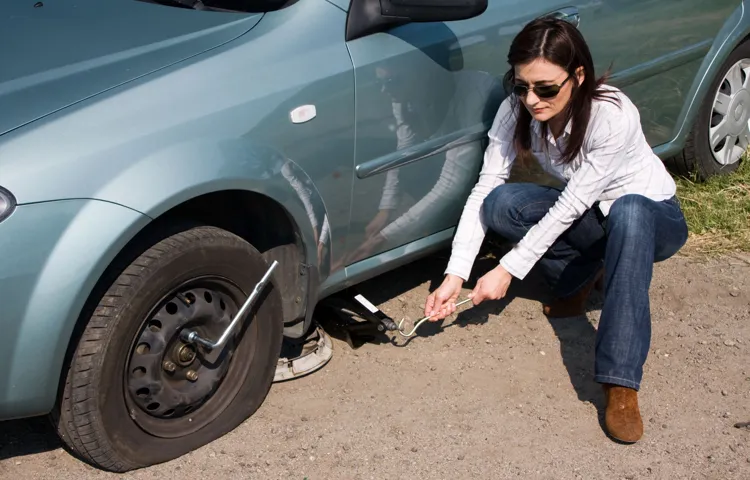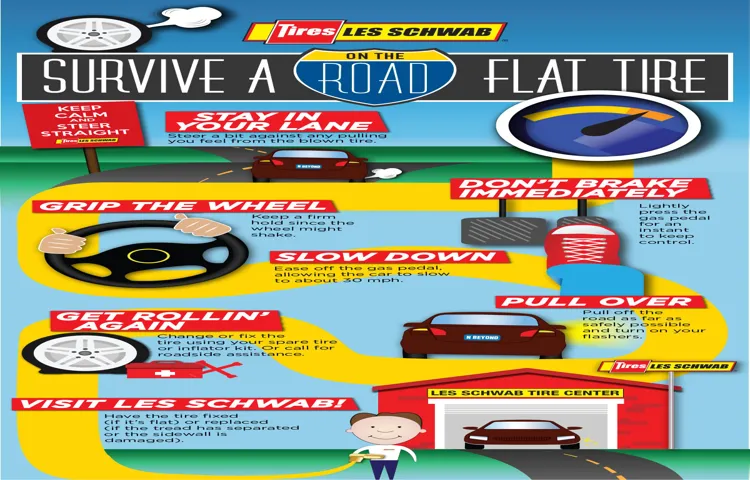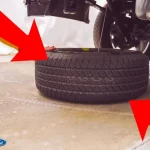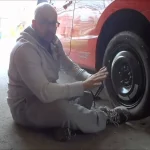Have you ever been driving on a bridge or through a tunnel when suddenly you hear a loud bang and feel your car start to wobble? Your heart begins to race as you glance in the rearview mirror to see debris and sparks flying. In moments like these, it’s crucial to stay calm and act quickly. Getting a flat tire can be a stressful situation no matter where it happens, but it can be even more unnerving when you’re on a bridge or in a tunnel with limited options for getting off the road.
In this blog, we’ll go over what to do when you get a flat tire in a tunnel or on a bridge to ensure your safety and the safety of others around you.
Table of Contents
Stay Calm and Pull Over Safely
If you experience a flat tire in a tunnel or on a bridge, the most important thing to do is to stay calm. Your safety and the safety of others on the road depend on your ability to remain level-headed. You should try to pull over as quickly and safely as possible, ideally onto the shoulder if one is available.
If there is no shoulder, try to move to the side of the road as much as possible while avoiding any obstacles. Once you have come to a stop, turn on your hazard lights and call for assistance. In the meantime, you may want to put on your hazard triangle or another warning device to alert other drivers.
Some people find it helpful to practice changing a tire before they actually need to do it, so they are prepared in case of an emergency. Overall, the key is to stay safe and take action as soon as possible when you encounter a flat tire.
Find a Safe Spot to Stop
When you’re driving, staying calm and collected behind the wheel is critical for your safety. One of the most important things you can do in an emergency situation is to find a safe spot to stop your vehicle. Whether you’re experiencing car troubles, a medical emergency, or a road hazard, pulling over safely is the first step to take.
Look for a flat and well-lit area away from traffic, such as a parking lot or a wide shoulder. Turn on your hazard lights to indicate to other drivers that you’re pulling over. Try to remain calm and collected, and don’t panic.
Staying calm will help you make rational decisions and keep everyone safe on the road. Remember, finding a safe spot to pull over is the first step towards resolving an emergency situation on the road.

Turn on Your Hazard Lights
When you experience car trouble, the first thing to do is stay calm. Panic can make things worse, so it’s essential to keep a clear head. Immediately turn on your hazard lights to signal to other drivers that you have an issue.
This will help make them aware of your situation and take precautions to safely avoid you. Once your hazard lights are on, try to move your vehicle to the side of the road as quickly as possible. Avoid making any sudden turns or movements that can cause an accident.
Once you’ve safely parked on the side, take a deep breath, and try to assess your vehicle’s problem. Whether it’s a flat tire or an overheated engine, it’s essential to stay patient and avoid any aggressive actions. Remember, your safety and the safety of others on the road is the top priority, and taking the necessary steps to pull over safely can make all the difference.
Assess the Situation
If you find yourself with a flat tire while driving in a tunnel or on a bridge, the first thing to do is to assess the situation. It’s important to remain calm and assess the level of danger before attempting to take any further action. Check to see if you’re in a safe place, such as a shoulder or emergency lane, and turn on your hazard lights to signal to other drivers that something is wrong.
If you’re on a bridge, try to move to the nearest exit if possible, or move slowly and steadily to the other end of the bridge, keeping an eye out for any obstacles or cars. Once you’re safely parked, call for emergency assistance or a roadside assistance service to help you change the tire. Remember to stay patient and follow safety protocols while waiting for assistance.
With a little bit of quick thinking and caution, you can safely handle a flat tire in any situation.
Check Your Tire and Surroundings
Assessing the situation before checking your tire and surroundings is crucial to ensuring your safety and avoiding accidents on the road. Look for a safe and level area to park your car and turn on your hazard lights. Take a walk around your car to check for any visible damage, obstacles, or hazardous materials that may pose a danger to you and others.
Then, get down on your knees and inspect all of your tires, including the spare, for any signs of wear and tear, punctures, or damage. Remember, regularly inspecting your tires will prolong their lifespan and prevent unexpected blowouts or flats while driving. By being proactive and assessing your surroundings, you can stay confident and secure on the road.
Determine If You Can Change the Tire Yourself
Before you attempt changing a tire, it’s crucial to assess the situation. Are you in a safe location to change the tire or do you need to move your car? Is the ground level or on a slope? Are there any obstacles hindering you from safely changing the tire? Additionally, consider your ability and knowledge of changing a tire. Have you done it before? Do you have the necessary tools and a spare tire? If you’re unsure about anything, it may be better to call for roadside assistance.
Don’t put yourself in harm’s way or risk further damaging your vehicle. Remember, safety should always be the top priority. Knowing your limitations and understanding the circumstances can help you determine if changing the tire yourself is feasible or if you should call for assistance.
Call for Help If Needed
Assessing the situation is crucial when determining whether or not to call for help. If the situation is dire and you or someone else is in immediate danger, do not hesitate to call emergency services such as 91 It’s better to err on the side of caution in cases where time is of the essence.
If the situation is not an emergency but still requires assistance, consider reaching out to friends, family, or professionals. Remember, it takes strength to ask for help, and there’s no shame in needing it. Utilize resources available to you, such as hotlines or counseling services, to help navigate difficult situations.
Seeking help can lead to positive outcomes and provide much-needed support during tough times. Together, we can overcome any obstacle, but never hesitate to call for help if needed.
Stay Safe While Waiting for Help
If you find yourself with a flat tire in a tunnel or on a bridge, it can be a nerve-wracking situation. Your safety should always come first, and there are a few steps you can take to stay safe until help arrives. First, try to continue driving if you can, until you reach a safer location.
If that is not an option, pull over as far to the right as possible and turn on your hazard lights. If you have road flares or reflective triangles in your car, use them to alert other drivers. It is important to stay in your car, even if it is hot or uncomfortable.
Only leave the car if you absolutely have to, and make sure to move away from the road and traffic. If you have a cell phone, call for help and give your location as accurately as possible. Remember, it is always better to be safe than sorry, so take precautions to stay safe until help arrives.
Stay Inside Your Vehicle
When you’re waiting for help on the side of the road, it’s important to stay inside your vehicle to ensure your safety. Whether you’ve experienced a breakdown or a flat tire, it can be tempting to step outside and assess the situation. However, it’s much safer to stay inside your car, especially when you’re in a busy or unfamiliar area.
By staying inside your car, you’re protected from other drivers and potential hazards. Plus, you’re more visible to passing drivers, which increases the chances of someone stopping to offer assistance. Remember to keep your doors locked and windows rolled up, and only open your window slightly if someone approaches your car.
By following these safety tips, you can stay safe while you wait for help to arrive. Remember, your safety should always be your top priority.
Keep Your Seatbelt Fastened
When you find yourself in an unexpected situation while driving, such as breaking down on the side of the road or experiencing a flat tire, it’s essential to keep your seatbelt fastened until help arrives. It may be tempting to get out of the car and assess the situation, but it’s safer to stay inside with your seatbelt on. This is especially important if you’re on the side of a busy highway or an area with high-speed traffic.
Keeping your seatbelt fastened can help prevent injury in the event of another vehicle colliding with your car, and it can also keep you in place if the car is suddenly jolted by a passing vehicle. Remember, your safety is the top priority, and you never know when help will arrive. So, keep your seatbelt on and stay safe while waiting for assistance.
Leave Your Vehicle If There Is Immediate Danger
When driving on the road, immediate danger can arise at any moment. You may find yourself in a situation where it’s safer to abandon your vehicle than to stay inside. If your vehicle breaks down and you are in a precarious location, it is best to leave the car, lock it up and walk to a secure location.
This could mean walking to the nearest petrol station or by the side of the road, but only after making sure it is safe to do so. While waiting for help, keep yourself visible to other road users by using hazard lights or cones if you have them available. Safety should always come first, so it’s better to be safe than sorry.
Remember, your vehicle can be replaced, but you can’t. Taking the right precautions and making sensible decisions could be what saves your life in an emergency situation.
Prevent Flat Tires in the Future
“What should you do if you have a flat tire in a tunnel or on a bridge?” is a common concern among drivers. It’s a frightening and potentially dangerous situation that requires immediate action. The best course of action in this situation is to first try to pull over to a safe area if possible.
If it’s not safe to change the tire due to the location, then call for emergency assistance right away. It’s important to remain calm and avoid abrupt maneuvers, as this could increase the risk of a serious accident. Prevention is key to avoiding a flat tire in the first place.
Regular maintenance checks on your vehicle, including checking the tire pressure and condition, can help prevent flats and identify potential issues before they become serious. Additionally, consider carrying a spare tire and necessary tools in your vehicle to help you change the tire on the spot if needed. By being proactive and prepared, you can improve your safety and avoid the frustration of a flat tire on the road.
Inspect Your Tires Regularly
Inspecting your tires regularly is one of the most effective ways to prevent flat tires in the future. Not only does it help you to detect any issues before they turn into major problems, but it also helps to prolong the life of your tires. Start by checking the air pressure in your tires at least once a month, as low pressure can lead to a blowout.
Additionally, inspect the tread on your tires to make sure they are not worn down unevenly or excessively, and check for any cracks or punctures on the sidewalls. It is also important to rotate your tires regularly to ensure even wear and tear. By taking these simple steps, you can reduce the likelihood of experiencing a flat tire, which can save you time, money, and frustration in the long run.
Avoid Overloading Your Vehicle
Overloading your vehicle is one of the main reasons for flat tires, which can be frustrating and stressful. However, this issue can be easily prevented with just a few simple steps. Firstly, always make sure to check your vehicle’s load capacity and never exceed it.
Overloading your car beyond its limit puts extra pressure on your tires and leads to quicker wear and tear of the rubber. Secondly, evenly distribute your luggage and packages across the car’s trunk and seats to ensure weight balance. This way, you’ll avoid putting too much weight on one tire and causing it to blow out.
Lastly, always ensure that your tires are inflated to the recommended pressure level as shown in your owner’s manual or on the tire’s sidewall. Proper inflation helps to reduce friction and heat build-up, which in turn extends tire life. In summary, by taking these easy precautions and being mindful of your vehicle’s load limit, you can avoid flat tires and enjoy a smoother and safer driving experience.
Drive Carefully and Avoid Potholes
As we hit the peak of pothole season, it’s important to remember to drive carefully and avoid these road hazards. Potholes can cause significant damage to your vehicle, especially to your tires. Nobody wants to deal with a flat tire, so prevention is key.
Keep an eye out for potholes and slow down when you approach them. If you can’t avoid one, try to hit it at a slower speed, and try to drive straight through it without changing direction. This will reduce the risk of damage to your tires.
Additionally, make sure your tires are properly inflated and have good tread so that they are better equipped to handle encounters with potholes. Remember, every time you hit a pothole, you increase the risk of costly repairs or even an accident. So, stay alert, drive carefully, and avoid potholes whenever possible to prevent flat tires from happening in the future.
Conclusion
If you find yourself with a flat tire in a tunnel or on a bridge, don’t panic! Take a deep breath, stay calm, and follow these steps: Pull over to the side as far as possible and turn on your hazard lights.
If you’re on a bridge, try to get to an area with wider shoulders or exits. Stay in your car if possible and call for assistance.
Be sure to let the dispatcher know your location and situation. If you have to change the tire yourself, make sure you have all the necessary tools and equipment.
Remember, safety should always come first. If you don’t feel comfortable changing the tire or if there’s heavy traffic, wait for professional help.
And just like that, you’ll be back on the road in no time. Flat tire? No problem – you’ve got this!
FAQs
What should I do if I have a flat tire in a tunnel?
If you have a flat tire in a tunnel, turn on your hazard lights and slowly move to the side of the road. If possible, try to get to an emergency lane or a safe location.
What should I do if I have a flat tire on a bridge?
If you have a flat tire on a bridge, signal that you are having a problem and try to move to the side of the road as quickly as possible. If there is no emergency lane, try to get as far to the right as possible.
I don’t have a spare tire, what should I do if I have a flat tire on a bridge or in a tunnel?
In case you don’t have a spare tire, call a tow truck or breakdown service and wait safely in your car until the help arrives.
Is it safe to change a flat tire in the middle of a tunnel or on a bridge?
No, it’s not safe to change a flat tire in the middle of a tunnel or on a bridge. It’s best to move to the side of the road and wait for help.
What are the dangers of changing a flat tire on a bridge or in a tunnel?
Changing a flat tire on a bridge or in a tunnel can be dangerous as it’s a confined space with limited visibility. It may be safer to wait for help to arrive.
How long should I wait for help if I have a flat tire in a tunnel or on a bridge?
Try to call for help right away and wait until someone arrives. It’s advisable to wait in your car until help arrives, especially in a tunnel or on a bridge.
What are some precautions I can take to avoid getting a flat tire on a bridge or in a tunnel?
Regularly inspect your tires, ensure that they have the right pressure, and avoid driving over debris. It’s also advisable to have a spare tire in your car in case of emergencies.



